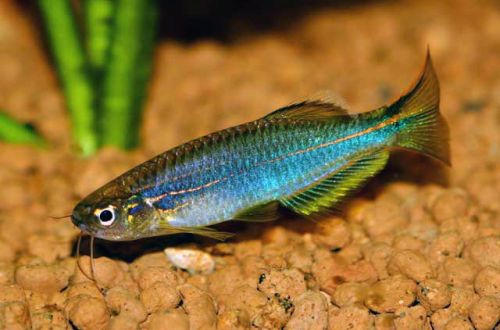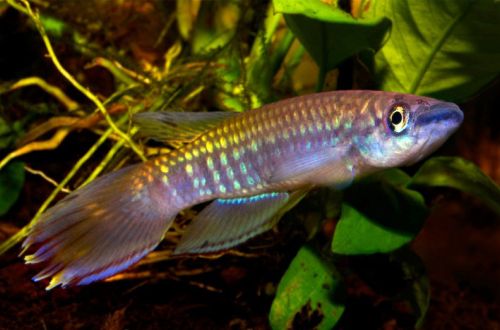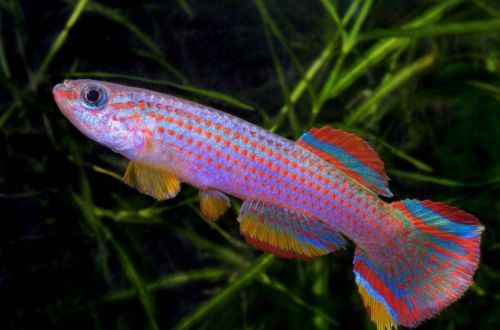
Danio Hikari
Danio Hikari, scientific name Danio sp. “Hikari”, belongs to the Cyprinidae family. Became available in the aquarium hobby since 2002. Previously considered a variety of Danio Kerry, however, based on DNA studies conducted in the United States, these fish have become an independent species. They are considered easy to keep and breed. They get along well with many other fish. May be recommended for beginner aquarists.

Contents
Habitat
It comes from Southeast Asia from the territory of southern Myanmar (Burma) of the administrative part of Taninthaya. Inhabits the Tenaserim River basin, occurs in small tributaries and slow-flowing rivers flowing under the canopy of the tropical forest.
Brief information:
- The volume of the aquarium – from 100 liters.
- Temperature – 18-26°C
- Value pH — 6.5–7.5
- Water hardness – 1–12 dGH
- Substrate type – soft dark
- Lighting – subdued
- Brackish water – no
- Water movement – light or moderate
- The size of the fish is about 5-6 cm.
- Feeding – any food of suitable size
- Temperament – peaceful
- Keeping in a group of 8-10 individuals
Description
Adult individuals reach a length of 5-6 cm. Males are light gray, blue-yellow stripes stretch along the body. The coloration of females is predominantly blue; longitudinal stripes are also present, but less pronounced.
Food
In nature, they feed on small aquatic insects and their larvae, crustaceans, worms, etc. Most popular foods are accepted in the aquarium – dry, live, frozen, freeze-dried, so there will be no problems with the choice of food.
Maintenance and care, arrangement of the aquarium
The optimal size of the aquarium for a small flock of Danio Hikari starts at 100 liters. The design uses dark soil and a large number of plants, artificial or natural. Various snags and other shelters will not be superfluous. The lighting is subdued. It is noted that in a half-empty tank with an excess of light, the color of the fish becomes faded.
Successful management is highly dependent on maintaining stable water conditions within acceptable temperature ranges and pH and dGH values. To do this, they use special aquarium equipment (at least filters and heaters), and also carry out regular maintenance: replacing part of the water with fresh water, cleaning the soil and decorative elements from organic waste and plaque.
Important! The aquarium should be equipped with a lid, if it is not provided initially, it will prevent the fish from jumping out.
Behavior and Compatibility
Peaceful active fish, compatible with many other non-aggressive freshwater species of comparable size. Prefers to be in a group of 8-10 individuals. With a smaller number, they become lethargic, slow, life expectancy is sometimes greatly reduced.
Breeding / breeding
Breeding in a home aquarium is not difficult. In favorable conditions, spawning occurs regularly. The fish scatter many eggs, which, from the moment they sink to the bottom, become left to themselves. Danio does not have developed parental instincts, so there is no care for offspring. The incubation period lasts about 24-36 hours, after a couple of days they begin to swim freely.
It is worth noting that although the organization of spawning in fish does not require any effort from the aquarist, the preservation of fry can be difficult. Juveniles become prey to other aquarium inhabitants and may also have trouble finding suitable food.
You can ensure safety and comfortable conditions for the fry in a separate tank, where it is worth transferring the eggs immediately after spawning. A tank of 20 liters or so is sufficient, filled with water from the main tank, and equipped with a simple airlift filter and heater. Feed with specialized powdered feed, Artemia nauplii.
Fish diseases
In a balanced aquarium ecosystem with species-specific conditions, diseases rarely occur. Often, diseases are caused by environmental degradation, contact with sick fish, and injuries. If this could not be avoided and the fish shows clear signs of illness, then medical treatment will be required. Read more about symptoms and treatments in the Aquarium Fish Diseases section.





